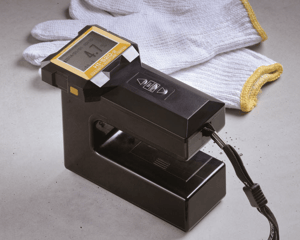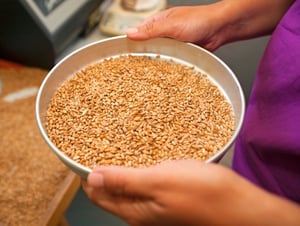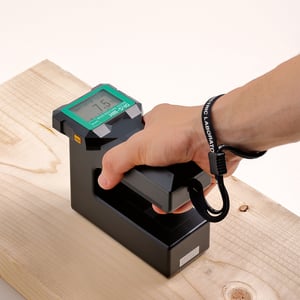When it comes to food safety and quality, there are two critical measurements that all food manufacturers should take: moisture content and water activity. While these measurements might sound similar, they are NOT the same—nor are they interchangeable.
Moisture content and water activity are measured for two different purposes. Each test reveals their own insights about the yield, quality, and safety of your foods. Even if water activity is your primary concern, accurate moisture content analysis is essential in meeting the established standard, and it’s crucial that you understand the measurements for each.
If you’re not sure why you need to measure both moisture content and water activity, we can help. This post will explain the differences between and the importance of each measurement.

Moisture content— AKA water content— is a measurement of the total amount of water contained in a food, usually expressed as a percentage of the total weight (see calculation). It’s a useful measurement for determining the dry weight of your food and ingredients and it helps calculate your total yield. It can also be used to confirm whether the drying process of your foods is finished.
Most raw materials’ cost is based upon weight, so manufacturers typically try to use as much water as possible while staying within the legal limits. By performing a simple moisture content test on incoming raw ingredients, you can ensure that you aren’t overpaying for free water.
Likewise, your food’s moisture content will have a direct effect on the way your food is processed, mixed, and dried, as well as the mouthfeel, appearance, and texture of the final product. Excess moisture can make your product runnier than desired and create clumping in dry mixes, neither of which is appealing to your consumers. To help give you a better idea of the moisture content of your ingredients, here’s a short list of the approximate moisture content of some common foods:
| Foods |
% Moisture |
| Apple | 84 |
| Orange | 87 |
| Grapes | 81 |
| Strawberry | 92 |
| Broccoli | 91 |
| Cucumber | 96 |
| Peppers | 92 |
| Potato | 79 |
| Beef (raw) | 73 |
| Chicken (raw) | 69 |
| Beef (cooked) | 62 |
| Chicken (cooked) | 62 |
| Salami, beef | 60 |
| Bread (commercially prepared) | 36 |
| Dried fruit | 31 |
| Jams/preserves | 30 |
| Beef Jerky | 23 |
| Wheat Flour | 11 |
| Cookies/biscuits | 6 |
| Peanut Butter | 2 |

Moisture content defines the amount of water in your food and ingredients, but water activity explains how the water in your food will react with microorganisms. The higher the water activity, the faster microorganisms like bacteria, yeast, and mold will be able to grow – resulting in higher standards of food storage.
Water activity is calculated by finding the ratio of the vapor pressure in food to the vapor pressure of pure water (see calculation below), and is primarily used to determine the necessary food storage requirements and shelf life of your products.
When you calculate water activity, you aren’t measuring the amount of water in a food; you’re actually measuring the “excess” amount of water that’s available for microorganisms to use. Every microorganism has a minimum and optimal water activity for growth, and it’s important that food manufacturers understand those cutoffs in order to control the growth of pathogens— thus preventing spoilage. Looking at the chart below, you’ll see the different types of microorganisms that are able to grow in a given water activity range:
| Range | Microorganisms Generally Inhibited by Lowest In This Range | Foods Generally With This Range |
| 1.00 - 0.95 | Pseudomonas, Escherichia, Proteus, Shigells, Klebsiella, Bacillus, Clostridium perfringens, some yeasts | Highly perishable (fresh) foods and canned fruits, vegetables, meat, fish, and milk |
| 0.95 - 0.91 | Salmonella, Vibrio parahaemolyticus, C. botulinum, Serratia, Lactobacillus, Pediococcus, some molds, yeasts (Rhodotorula, Pichia) | Some cheeses (Cheddar, Swiss, Muenster, Provolone), cured meat (ham) |
| 0.91 - 0.87 | Many yeasts (Candida, Torulopsis, Hansenula), Micrococcus | Fermented sausage (salami), sponge cakes, dry cheeses, margarine |
| 0.87 - 0.80 | Most molds (mycotoxigenic penicillia), Staphyloccocus aureus, most Saccharomyces (bailii) spp., Debaryomyces | Fruit juice concentrates, sweetened condensed milk, syrups |
| 0.80 - 0.75 | Most halophilic bacteria, mycotoxigenic aspergilli | Jam, marmalade |
| 0.75 - 0.65 | Xerophilic molds (Aspergillus chevalieri, A. candidus, Wallemia sebi), Saccharomyces bisporus | Jelly, molasses, raw cane sugar, some dried fruits, nuts |
| 0.65 - 0.60 | Osmophilic yeasts (Saccharomyces rouxil), few molds (Aspergillus echinulatus, Monascus bisporus) | Dried fruits containing 15-20% moisture, some toffees and caramels, honey |
| < 0.60 | No microbial proliferation |
If your food has a water activity range above .85, it will have to be refrigerated or use another barrier in order to control the growth of pathogens. If your food has a water activity range between .60 and .85, it won’t require refrigeration, but will have a limited shelf-life due to yeasts and molds.
Finally, if your food has a water activity below .60, it will have an extended shelf-life, even without refrigeration. Food manufacturers can employ several tactics, including drying, freezing, or adding solutes like salt or sugar, to help reduce their products’ water activity levels and extend their shelf life.
Measuring Moisture Content and Water Activity
With both measurements being critical to your foods’ safety and quality, it’s important for food manufacturers to have accurate, reliable calculations for each. Unfortunately, there aren’t many instruments that can multi-task, taking these two very necessary measurements simultaneously.
In order to make sure that your products have the optimal levels of moisture content and water activity, food manufacturers should use a Kett moisture meter and a separate water activity analyzer to ensure that your foods are within their established specs. You can even use our moisture meter to identify the end point of your drying method to help reach your desired water activity levels. As many customers have told us, when they use an instant analyzer, they are able to always maximize their moisture content (yield) and avoid failing a water activity test.
Want to learn more? Download our free eBook for helpful tips on finding the perfect instrument for measuring the moisture content and water activity levels in your foods.
if you'd like to speak with one of our application engineers on how we can provide both measurements simultaneously, without sample alteration, click here



